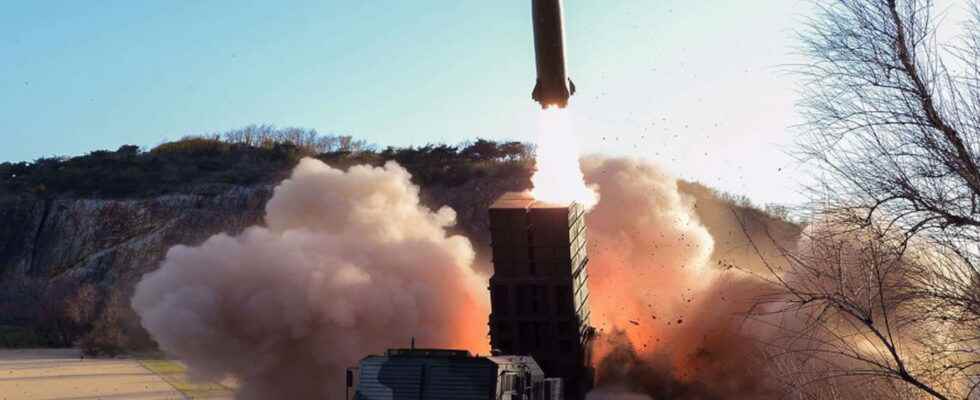NUCLEAR WAR. The threats were rarer but the vice-president of the Security Council of Russia, Dmitry Medvedev, again spoke of the outbreak of a nuclear war against the West, Wednesday July 6, 2022.
[Mis à jour le 7 juillet 2022 à 14h52] It is the return of the nuclear threat. In the fifth month of the war in Ukraine, Russian politicians are again waving their nuclear arsenal in the face of the West. “The very idea of chastising a country that has the largest nuclear arsenal in the world is absurd in itself. And it potentially creates a threat to the existence of humanity,” the author wrote.e Vice-President of the Security Council, Dmitry Medvedev on his account TelegramWednesday, July 6, 2022. If this warning is signed by Moscow, the former president of Russia indirectly places the responsibility for a possible nuclear war on the International Criminal Court (ICC) which has opened an investigation into alleged crimes committed in Ukraine by Russian forces. Implicitly, the politician suggests that a nuclear attack would be a response to a condemnation of Moscow by international justice.
This is not Dmitri Medvedev’s first nuclear threats. The last outing of the former Russian Prime Minister dates back to March when he detailed the scenarios in which Russia could use its nuclear weapons. Scenarios that often blamed the West. Since the start of the war in Ukraine, Russia has multiplied its threats and accusations against the United States and NATO and has put Cold War tensions back on the table, suggesting that the Russian-Ukrainian conflict could be a prequel to a world war. Dmitry Medvedev’s statement adds to the list of nuclear threats made by Russia, but all of them, including this one, are part of a deterrence strategy.
Is nuclear war possible in 2022?
Threats of nuclear war have been a Russian refrain since the beginning of 2022. They go hand in hand with the invasion of Ukraine by Russian forces launched on February 24 and have since been regularly uttered by the leaders of the Kremlin. Foreign Minister Sergey Lavrov, Security Council Deputy Chairman Dmitry Medvedev and even Russian President Vladimir Putin were the first to suggest launching a nuclear war against the West. With each new threat, American and European intelligence services have reported the absence of suspicious movement on Russian military bases, suggesting that allusions to nuclear attacks are only deterrence strategies. But at the end of June, Russia like NATO would have placed their pawns in anticipation of a strike. “The Americans have 200 tactical nuclear weapons stored in six European countries that are members of the North Atlantic bloc, and 257 planes, not only American, have been prepared for their possible use,” Vladimir Putin told Belarusian President Alexander Lukashenko on June 25. at a meeting in St. Petersburg. In response, Moscow promised Minsk to supply it “in the coming months” with “a number of Iskander-M tactical missile systems” that can “fire ballistic and cruise missiles with conventional and nuclear warheads”.
Once again Russia puts forward and prepares its weapons and missiles while ensuring that it takes simple precautions against the movements and intentions that it attributes to the West. But Vladimir Putin’s accounts of Western weapons aren’t good, according to researcher Hans M. Kristensen, director of the Nuclear Information Project at the Federation of American Scientists. “It is interesting to see the Russian government using our old estimates of the number of American nuclear bombs in Europe. The current estimate is half, about 100. And they are in five countries, not six. The figure of 257 fighters” prepared “is also too high, they are probably less than 100,” said the researcher, who is accustomed to criticism of the modernization programs of the American nuclear forces according to the comments reported by the Figaro. If the time still seems to be for deterrence rather than a nuclear offensive, the West remains on its guard against Russia’s relentless military escalation since the start of the war in Ukraine.
What do simulations of a Russian nuclear attack predict?
Nuclear war is still only about threats. If the warnings are essentially statements by Russian politicians, they have found an echo in certain media close to the Kremlin. Between April and May, a new form of propaganda appeared on Russian public channels like Rossiya 1. On April 28, 2022, presenter Olga Skabeyeva who supports the Russian invasion of Ukraine and her guests had fun explaining to viewers that it only took a few minutes for a missile to smash Berlin, Paris or London off the map. Praising the strike force of Russia, in particular the possession of the Sarmat missile called “Satan 2”, they have, with computer graphics in support, followed in real time the hypothetical sending of the missile on the European capitals: 106 seconds to hit Berlin, 200 for Paris and 202 for London. An apocalyptic scenario that aroused the laughter of the personalities on set.
The simulations of such a nuclear attack, however, have lead in the wing. Firstly because the Satan 2 missile is still in the test phase and must remain so at least until the end of the year, which cuts short all the scenarios imagined on Rossiya 1. And even if the missile were ready to use, the simulations foresee a launch from the enclave of Kaliningrad but this Russian base is not equipped to launch a nuclear missile. The time elapsed between the launch and the impact of the missile is also incorrect, according to specialist Benjamin Gravisse with Release. On the other hand, the few extra minutes between launch and impact would not change the damage caused by nuclear warheads capable of destroying territory over tens or even hundreds of kilometers, hundreds of thousands for the Satan 2 missile.
